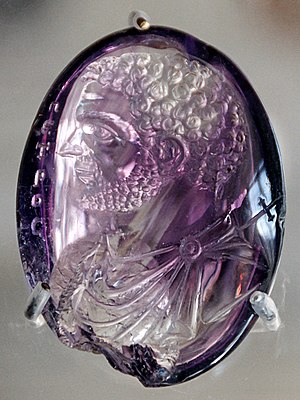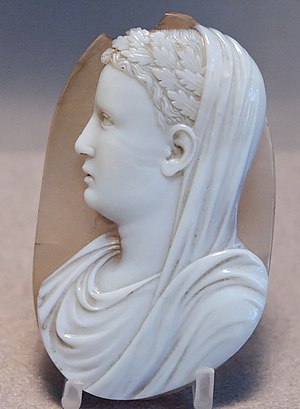
Back جوهرة منقوشة Arabic Гема Byelorussian Гема Bulgarian Gema Czech Gemme Danish Gemme German Joya grabada Spanish Rezbareni dragulj Croatian Գեմմա Armenian Ukiran permata ID


An engraved gem, frequently referred to as an intaglio, is a small and usually semi-precious gemstone that has been carved, in the Western tradition normally with images or inscriptions only on one face.[1] The engraving of gemstones was a major luxury art form in the ancient world, and an important one in some later periods.[2]
Strictly speaking, engraving means carving in intaglio (with the design cut into the flat background of the stone), but relief carvings (with the design projecting out of the background as in nearly all cameos) are also covered by the term. This article uses cameo in its strict sense, to denote a carving exploiting layers of differently coloured stone. The activity is also called gem carving and the artists gem-cutters. References to antique gems and intaglios in a jewellery context will almost always mean carved gems; when referring to monumental sculpture, the term counter-relief, meaning the same as intaglio, is more likely to be used. Vessels like the Cup of the Ptolemies and heads or figures carved in the round are also known as hardstone carvings.
Glyptics or glyptic art covers the field of small carved stones, including cylinder seals and inscriptions, especially in an archaeological context. Though they were keenly collected in antiquity, most carved gems originally functioned as seals, often mounted in a ring; intaglio designs register most clearly when viewed by the recipient of a letter as an impression in hardened wax. A finely carved seal was practical, as it made forgery more difficult – the distinctive personal signature did not really exist in antiquity.
- ^ Fully half of the antique engraved gems in the Berlin museums and the British Museum are either sard or carnelian, Etta M. Saunders, noted. Saunders, "Goddess Riding a Goat-Bull Monster: A Ceres Zodiac Gem from the Walters Art Gallery" The Journal of the Walters Art Gallery 49/50 (1991/1992;7–11) note 19
- ^ The three preeminent European collections of post-Classical engraved gems are the Cabinet des Médailles at the Bibliothèque nationale, Paris, the Habsburg collection, Vienna, and the British Museum, London, O. M. Dalton observed in "Mediæval and Later Engraved Gems in the British Museum — I" The Burlington Magazine for Connoisseurs 23 No. 123 (June 1913:128-136) and "II" The Burlington Magazine for Connoisseurs 24 No. 127 (October 1913:28–32).
© MMXXIII Rich X Search. We shall prevail. All rights reserved. Rich X Search